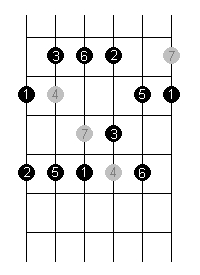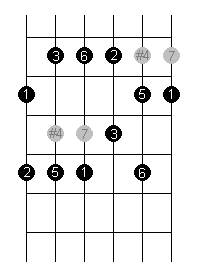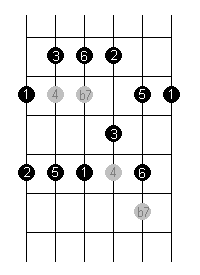
All of the scales that we've looked at so far have had seven notes in them - one for each letter of the alphabet from A to G (although sometimes with the odd # or b sign thrown in). There are some other scales around which have fewer notes, and they deserve a place in your musical vocabulary - namely the penatonic scales.
As the name suggests, a pentatonic scale has 5 notes (from the Latin 'pent' meaning 'five', as in pentagon, pentagram, etc.). In this tutorial, we'll look at the major pentatonic, but there is also a minor pentatonic scale (more about this one in a later tutorial).
To start with, imagine sitting at a piano keyboard, and playing just the black notes (if you aren't familiar with the layout of a piano keyboard, then the black notes are the accented ones).
This gives us a pattern of five notes. You may be wondering why this example here has started with F# and not C#, D# or any other note. There is a good reason for this, and to explain why we've used F#, consider the notes of the F# major scale, compared with the notes of the F# major pentatonic:
Notice how the notes of major pentatonic scale match some of the notes of the major scale with the same root note. Using the parallel major scale as our reference, we can say that the major pentatonic scale has the formula 1-2-3-5-6 (it's the interval of a major third between the 1 and 3 degrees that makes this a 'major' pentatonic).
| If you're reading then you're probably a guitarist. That being the case, you'll probably want to know how to play this scale on the guitar. Have a look at this scale box: |  |
Now have a look at the following three scale boxes. They are for the three major scale modes, with the degrees that also occur in the major pentatonic scale highlighted. If you're not familiar with major scale modes, then there is a tutorial elsewhere which covers them.
 Ionian Mode |
 Lydian Mode |
 Mixolydian Mode |
|---|
The thing to notice here is that all three of the major scale modes include the notes of the parallel major pentatonic. In effect, you can think of the major pentatonic scale as being a 'skeleton' for the major scale modes. What this also means is that in any situation where you can play a major scale mode, you can also stick to notes of the corresponding major pentatonic scale.
There is also a minor pentatonic scale, but more about that later. In the meantime, take a while to get familiar with the major pentatonic scale. As well as getting comfortable with the theory, also take the time to practise playing the scale and using it in your playing. Good luck.
How useful did you find this tutorial?
| Product/Info... | PhatPhish Application | | | Product Help | | | GUPPY - PhatPhish for the web | | | About The Author |
|---|
| Get Stuff... | Download PhatPhish | | | Mechandise | | | Blank Stave And Tab Sheets | | | Tutorials |
|---|
| Do Stuff... | Register | | | Feedback | | | Links | | | Donate | | | Ask A Question |
|---|
| Social Media... | YouTube | | | | |
|---|
| Promote... | Spread The Word | | | Posters/Flyers |
|---|
| Play... | PhatPhish Picks - Boutique Plectrums |
|---|
| ©2002-2022, Dave Dixon / CyberFlotsam http://www.cyberflotsam.com |